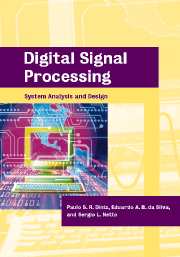Book contents
- Frontmatter
- Contents
- Preface
- Introduction
- 1 Discrete-time systems
- 2 The z and Fourier transforms
- 3 Discrete transforms
- 4 Digital filters
- 5 FIR filter approximations
- 6 IIR filter approximations
- 7 Finite-precision effects
- 8 Multirate systems
- 9 Filter banks and wavelets
- 10 Efficient FIR structures
- 11 Efficient IIR structures
- 12 Implementation of DSP systems
- References
- Index
9 - Filter banks and wavelets
Published online by Cambridge University Press: 05 June 2012
- Frontmatter
- Contents
- Preface
- Introduction
- 1 Discrete-time systems
- 2 The z and Fourier transforms
- 3 Discrete transforms
- 4 Digital filters
- 5 FIR filter approximations
- 6 IIR filter approximations
- 7 Finite-precision effects
- 8 Multirate systems
- 9 Filter banks and wavelets
- 10 Efficient FIR structures
- 11 Efficient IIR structures
- 12 Implementation of DSP systems
- References
- Index
Summary
Introduction
In the previous chapter, we dealt with multirate systems in general, that is, systems in which more than one sampling rate coexist. Operations of decimation, interpolation, and sampling-rate changes were studied, as well as some filter design techniques using multirate concepts.
In a number of applications, it is necessary to split a digital signal into several frequency bands. After such decomposition, the signal is represented by more samples than in the original stage. However, we can attempt to decimate each band, ending up with a digital signal decomposed into several frequency bands without increasing the overall number of samples. The question is whether it is possible to exactly recover the original signal from the decimated bands. Systems which achieve this are generally called filter banks.
In this chapter, we first deal with filter banks, showing several ways in which a signal can be decomposed into critically decimated frequency bands, and recovered from them with minimum error. Later, wavelet transforms are considered. They are a relatively recent development of functional analysis that is generating great interest in the signal processing community, because of their ability to represent and analyze signals with varying time and frequency resolutions. Their digital implementation can be regarded as a special case of critically decimated filter banks. Finally, we provide a brief description of functions from the MATLAB Wavelet toolbox which are useful for wavelets and filter banks implementation.
- Type
- Chapter
- Information
- Digital Signal ProcessingSystem Analysis and Design, pp. 375 - 452Publisher: Cambridge University PressPrint publication year: 2002



